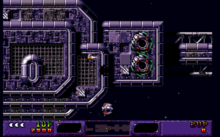
Paradroid is a Commodore 64 computer game written by Andrew Braybrook and published by Hewson Consultants in 1985. It is a shoot 'em up with puzzle elements and was critically praised at release. The objective is to clear a fleet of spaceships of hostile robots by destroying them or taking them over via a mini-game. It was later remade as Paradroid 90 for the Commodore Amiga and Atari ST home computers and as Paradroid 2000 for the Acorn Archimedes. There exist several fan-made remakes for modern PCs. In 2004 the Commodore 64 version was re-released as a built-in game on the C64 Direct-to-TV, and in 2008 for the Wii Virtual Console in Europe.

Graftgold was an independent computer game developer that came to prominence in the 1980s, producing numerous computer games on a variety of 8-bit, 16-bit and 32-bit platforms.

Walker is a horizontally scrolling shooter video game developed by DMA Design and published by Psygnosis for the Amiga in February 1993. The player controls a bipedal mech and is tasked with killing advancing enemies in stages set in multiple time periods. Development of the game began after the release of Blood Money, but was scrapped in 1990 because the game was not coming together. By the end of the year, development had recommenced with a redesign, inspired by sprites originally intended for Blood Money. Ian Dunlop and Neill Glancy designed the game, and Raymond Usher wrote its soundtrack. The game was released to positive reviews with praise directed at the game's graphics and sound, but reviewers were critical towards the repetitiveness of the gameplay. Amiga Power ranked it among their top 100 Amiga games of 1993.

Uridium is a science fiction side-scrolling shoot 'em up initially designed by Andrew Braybrook for the Commodore 64, and later ported to other 8-bit machines. It consists of fifteen levels, each named after a metal element, with the last level being called Uridium. The manual quotes Robert Orchard, who invented the name as saying "I really thought it existed".
The Lotus series consists of three racing computer games based around the Lotus brand: Lotus Esprit Turbo Challenge, Lotus Turbo Challenge 2, and Lotus III: The Ultimate Challenge. Published between 1990 and 1992 by Gremlin Graphics, the games gained very favourable reviews upon release. Original Amiga versions of the games were created by Shaun Southern and Andrew Morris of Magnetic Fields, and then ported by other individuals to several other computers and game consoles.

Star Goose is a vertically scrolling shooter that was published for the Amiga, Atari ST, and MS-DOS by Logotron in 1988. The player controls Scouser-Gitt, who pilots the eponymous Star Goose, a vessel that has been commissioned to scour the planet Nom and collect 48 crystals. Players must collect all six crystals in each of the game's eight levels to advance, while at the same time avoiding or destroying enemies and maintaining their shield, ammunition, and fuel levels. The game's surfaces are contoured, which affects the way that bullets travel, and contain tunnels that switch modes to a three-dimensional perspective where the player can replenish their resources.

Xenon 2: Megablast is a 1989 shoot 'em up video game developed by The Bitmap Brothers and published by Image Works for the Amiga and Atari ST. It was later converted to the Master System, PC-98, X68000, Mega Drive, Commodore CDTV, Game Boy, Acorn Archimedes and Atari Jaguar platforms. The game is a sequel to Xenon and takes place a millennium after the previous title. The goal of the game is to destroy a series of bombs planted throughout history by the Xenites, the vengeful antagonists of the first game.

Sanxion is a horizontally scrolling shooter developed by Stavros Fasoulas for the Commodore 64 and published in 1986 by Thalamus Ltd. It was the first game released by Thalamus. A ZX Spectrum port followed in 1989. Fasoulas also wrote Delta and Quedex.

Silkworm is a horizontally scrolling shooter developed by Tecmo and first released for arcades in 1988. In 1989, it was ported to the Amiga, Atari ST, Commodore 64, ZX Spectrum, Amstrad CPC and NES (1990) systems by The Sales Curve and released by Virgin Mastertronic.
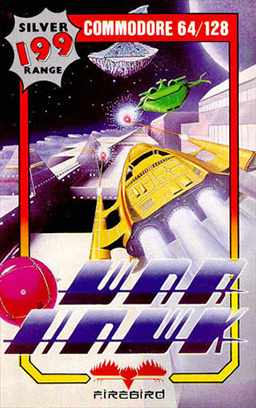
Warhawk is a vertically scrolling shooter published in 1986 by Firebird Software. It was released for the Commodore 64, Atari 8-bit computers, Amstrad CPC, and Atari ST.

Dropzone is a horizontally scrolling shooter developed by Archer Maclean for Atari 8-bit computers and published in 1984 by U.S. Gold. It was ported to the Commodore 64, and later released for the Nintendo Entertainment System, Game Boy, Game Gear, and Game Boy Color. Ports for Master System and Sega Genesis were also announced, but never released.

Fire and Ice: The Daring Adventures of Cool Coyote is a platform game created by Graftgold for the Amiga and the Atari ST, released in 1992 by Renegade.
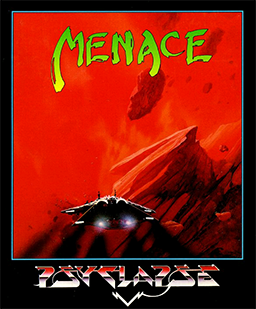
Menace is a horizontally scrolling shooter developed by DMA Design and published by Psygnosis. It was released for the Amiga and Atari ST in 1988, and for the Commodore 64 and MS-DOS in 1989. The game is set on the planet of Draconia, where players are tasked with destroying the planet's defence mechanisms in order to kill the harmful creatures.
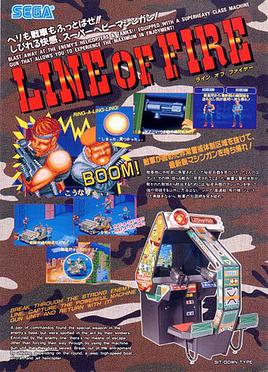
Line of Fire / Line of Fire: Bakudan Yarou is a first-person light gun shooter game developed by Sega and released for arcades in 1989. It was released with two arcade cabinet versions, a standard upright and a sit-down cockpit, both featuring two positional guns. The cockpit design allows the player(s) to sit down while playing the game, while having two-handed machine guns, controlled by a potentiometer-controlled gun alignment software system. The game follows a two-man commando unit as they try to escape from a terrorist facility after seizing a prototype weapon.
Cope-Com is a Danish Amiga software developer founded in 1987 by Martin B. Pedersen and Torben B. Larsen.

The Real Ghostbusters is a 1987 shoot 'em up arcade game developed and published by Data East. It is loosely based on Ghostbusters. In Japan, Data East released it as a non-Ghostbusters arcade game under the title Meikyuu Hunter G. In 1989, Activision published The Real Ghostbusters for Amiga, Amstrad CPC, Atari ST, Commodore 64, and ZX Spectrum.
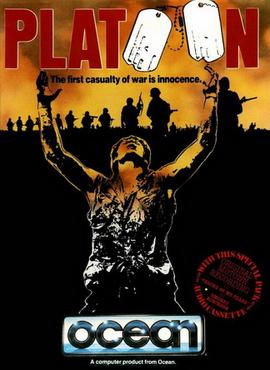
Platoon is an action game developed by Ocean Software and published by Data East for the Amiga, Amstrad CPC, Apple II, Atari ST, Commodore 64, MS-DOS, and ZX Spectrum in 1987–1988. The Nintendo Entertainment System version was ported and published by Sunsoft in September 1988. It was the first video game adaptation of the 1986 war film Platoon, followed by the 2002 game.
A vertically scrolling video game or vertical scroller is a video game in which the player views the field of play principally from a top-down perspective, while the background scrolls from the top of the screen to the bottom to create the illusion that the player character is moving in the game world.

P-47: The Phantom Fighter is a 1988 horizontally scrolling shooter arcade video game originally developed by NMK and published by Jaleco. Set during World War II, players control a Republic P-47 Thunderbolt fighter aircraft to face against the Nazis, who are occupying multiple countries around the world. Its gameplay involves destroying waves of enemies, picking up power-ups and new weapons, and destroying bosses. It ran on the Mega System 1 hardware.

Mirax Force is a horizontally scrolling shooter video game written by Chris Murray and published by Tynesoft in 1987 for Atari 8-bit computers. The game is heavily inspired by Uridium, which was released a year earlier.
